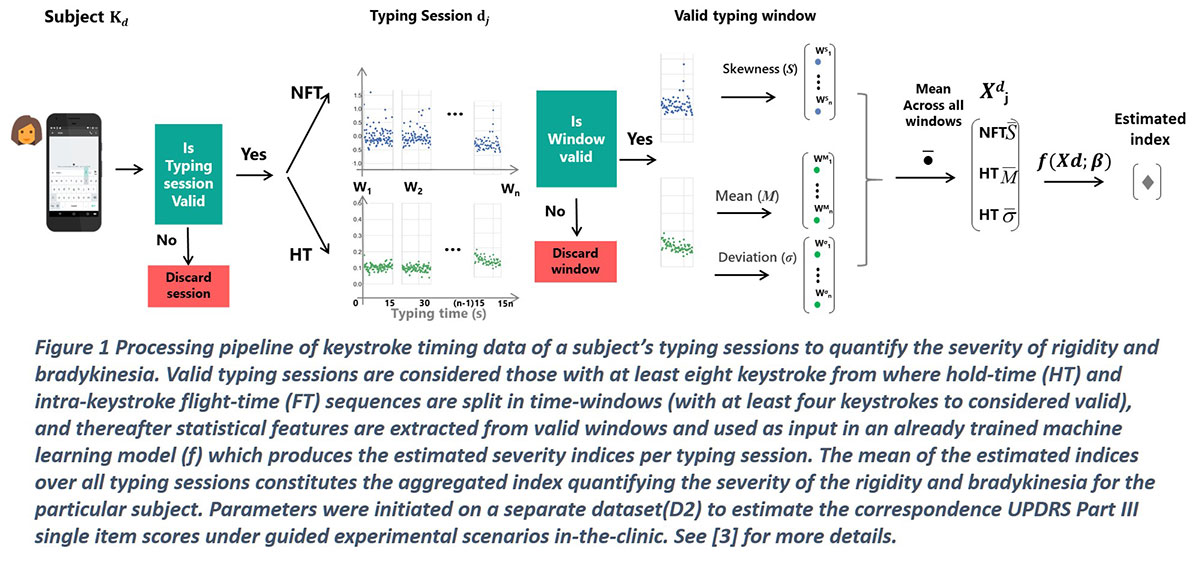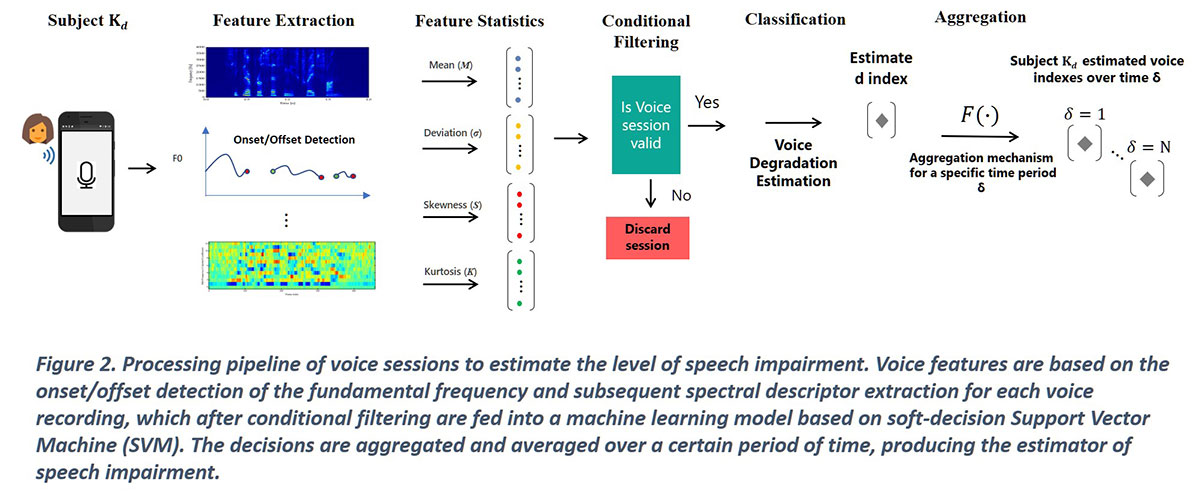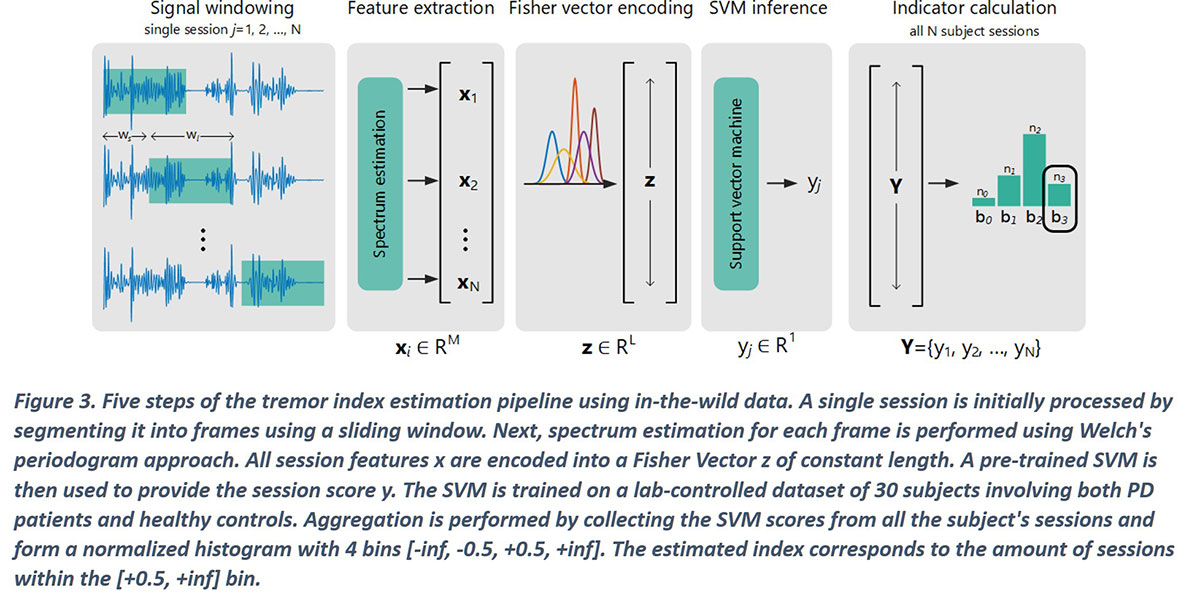Session Information
Date: Tuesday, September 24, 2019
Session Title: Parkinsonisms and Parkinson-Plus
Session Time: 1:45pm-3:15pm
Location: Agora 3 West, Level 3
Objective: To provide clinically-corroborated evidence of the Parkinson’s disease (PD) diagnostic potential of machine learning-based approaches for motor symptoms severity inference via multimodal data, passively captured during the natural use of smartphones.
Background: PD symptoms can be mild in the early stages and they usually go unnoticed, leaving the disease undiagnosed for years [1]. Subtle motor manifestations may start five to six years prior to PD clinical diagnosis and thereafter progress quickly [2]. Motor impairment affects daily activities and can severely impact patients’ quality over the course of the disease. Information derived from mobile electronic sensors can provide, via algorithmic transformation, objective and dense information of an individual’s motor status, allowing for frequent relevant symptoms early screening and subsequent monitoring.
Method: We analyzed longitudinal recordings of tri-axial accelerometer, voice and keystroke timing data, captured passively from 70 PD patients and healthy controls (HC) [Table 1], in their daily life via the iPrognosis Android smartphone application, for relevant motor symptoms severity inference. [Figure1], [Figure2] and [Figure3] depict the proposed processing pipelines, whereas, [Table 2], [Table 3] and [Table 4] epitomize the datasets exploited per modality. Voice features and accelerometer data were captured while subjects were using their mobile device for phone calls, to infer speech impairment and action tremor, respectively. Moreover, keystroke timing data were captured during touchscreen typing on the iPrognosis custom software keyboard and analyzed to estimate dominant-hand rigidity and bradykinesia severity [3]. Subjects underwent medical evaluation in order to obtain the UPDRS Part-III scores used as ground truth.
Results: Diagnostic (PD patient vs. HC) performance of the symptom-inference pipelines is summarized in [Table5].
Conclusion: The proposed methods for motor symptoms inference show promising PD diagnostic performance in our relatively small clinically-evaluated cohorts. Our results highlight the potential of evolving these methods into an objective PD screening/monitoring tool that could support clinical diagnosis, drug response assessment and decision-making. Passive capturing of the required input data further fosters evaluation of individuals’ natural behavior, as well as long-term adherence.
References: 1. Hawkes, C. H., Del Tredici, K., and Braak, H. (2010). A timeline for Parkinson’s disease. Parkinsonism Relat. Disord. 16, 79–84. doi: 10.1016/j.parkreldis.2009.08.007 2. Fereshtehnejad, S. M., et al. “Evolution of Motor and Non-Motor Manifestations in Prodromal Parkinsonism.” MOVEMENT DISORDERS. Vol. 33. No. 12. 111 RIVER ST, HOBOKEN 07030-5774, NJ USA: WILEY, 2018. Hawkes, Christopher H., Kelly Del Tredici, and Heiko Braak. “A timeline for Parkinson’s disease.” Parkinsonism & related disorders 16.2 (2010): 79-84. 3. Iakovakis, Dimitris, et al. “Motor impairment estimates via touchscreen typing dynamics towards Parkinson’s disease detection from data harvested in-the-wild.” Frontiers in ICT 5 (2018): 28.
To cite this abstract in AMA style:
D. Iakovakis, S. Hadjidimitriou, V. Charisis, K. Kyritsis, A. Papadopoulos, M. Stadtschnitzer, H. Jaeger, I. Dagklis, S. Bostantjopoulou, Z. Katsarou, L. Klingelhoefer, S. Mayer, R. Reichmann, D. Trivedi, A. Podlewska, A. Rizos, K. Chaudhuri, A. Delopoulos, L. Hadjileontiadis. Towards unobtrusive Parkinson’s disease detection via motor symptoms severity inference from multimodal smartphone-sensor data [abstract]. Mov Disord. 2019; 34 (suppl 2). https://www.mdsabstracts.org/abstract/towards-unobtrusive-parkinsons-disease-detection-via-motor-symptoms-severity-inference-from-multimodal-smartphone-sensor-data/. Accessed December 25, 2025.« Back to 2019 International Congress
MDS Abstracts - https://www.mdsabstracts.org/abstract/towards-unobtrusive-parkinsons-disease-detection-via-motor-symptoms-severity-inference-from-multimodal-smartphone-sensor-data/








